Scent and Subversion (7 page)
Read Scent and Subversion Online
Authors: Barbara Herman

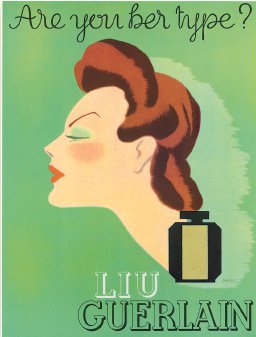
Are you Liù’s type? Maybe if you’re a redhead, implies this 1938 advertisement.
Perfumer:
Jacques Guerlain
If Chanel No. 5 and Shalimar had a baby, Liù would be their love child: An aldehydic floral based around jasmine and rose, Liù is powdery, sumptuous, and comforting, with a deep amber-vanilla base. Often described as Chanel No. 5 without the musk, Liù’s subtly fresh neroli note keeps the entire perfume from sinking into a decadent stupor, but not by much.
Top notes:
Aldehydes, bergamot, neroli
Heart notes:
Jasmine, rose, orris
Base notes:
Woody notes, vanilla, amber
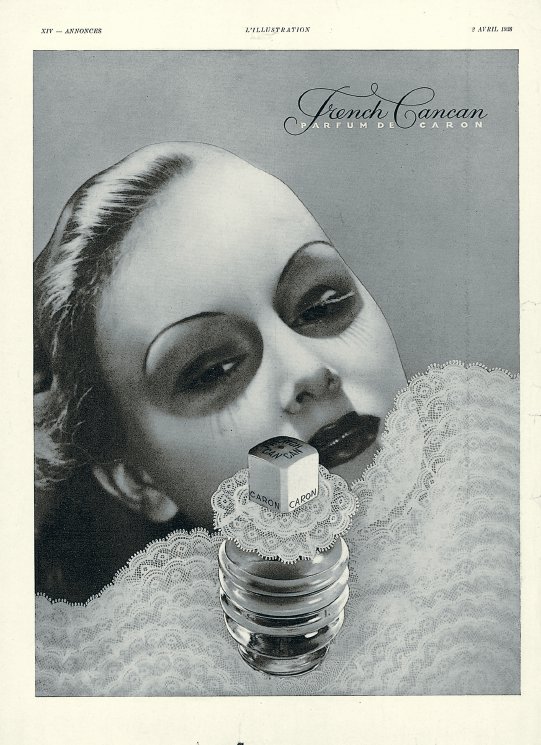
This 1938 ad for Caron’s French Cancan features a sultry close-up of a woman who looks like a movie star.
Tabu, Scandal, Shocking (1930–1939)
T
he 1930s was the decade of the Oriental fragrance—not only as a category with sumptuous notes, but because of the decade’s preoccupation with exotic fantasies of distant lands: the hot Moroccan desert winds that blow through Lucien Lelong’s Sirocco; the French colonies of Jean Patou’s Colony, with its tropical plantation accords of pineapple and rubber; and Tuvaché’s campy Jungle Gardenia, invoking an island paradise. Even the decade’s most famous floral, Joy, although not in the Oriental category, is loaded down with that category’s decadence and richness.
by Jean Patou (1930)
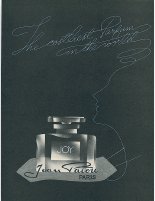
This 1937 ad marketed Joy as “the costliest perfume in the world” during the Great Depression.
Perfumer:
Henri Alméras
Released during the Great Depression and provocatively described as “the world’s most expensive perfume,” Joy, conceived by Jean Patou as a decadent gift to his American consumers, is considered to be one of the greatest floral perfumes ever created.
Joy is a velvety profusion of florals, with rose, jasmine, and ylang-ylang in their most decadent, gilded glory. Perfumer Jean Kerléo, Alméras’s successor, claimed that Joy’s richness comes from its jasmine and Bulgarian rose—not its base notes. Its voluptuous drydown has an almost tropical flower/coconut feel.
In spite of Joy’s luxe reputation, my favorite anecdote about the perfume is on the louche side,
and comes from
GQ
writer Glenn O’Brien: It’s rumored that the Rolling Stones’s grizzled bassist Keith Richards has worn Joy under his armpits for years. Rather than diminishing Joy, this makes me give even more props to Keith for his excellent taste.
Top notes:
Leafy green, aldehydes, peach, blossom-calyx notes
Heart notes:
Rose, jasmine, ylang-ylang, orris, orchid, lily of the valley
Base notes:
Sandal, musk, civet
by Worth (1932)
Perfumer:
Maurice Blanchet
With three floral notes that can be read as irredeemably old-fashioned to modern noses—lilac, hyacinth, and violet—Je Reviens nevertheless balances them with sensuous balsamic notes against smooth sandalwood, moss, and vetiver. The reformulations have been roundly panned (“Like bug spray” was a common refrain), so stick to bottles that are labeled paris, france. What’s missing in later reformulations is the rich, woody base.
Top notes:
Aldehydes, orange blossom, violet, bergamot
Heart notes:
Clove, hyacinth, jasmine, rose, ylang-ylang, orris, lilac
Base notes:
Vetiver, tonka, tolu, amber, musk, sandalwood, moss
by Tuvaché (1932)
Jungle Gardenia by Tuvaché was love at first sniff. Some perfumes dillydally around, making small talk, trying to get to know you, requiring that you buy them dinner and learn their childhood pets’ names and personalities, and so on. You may not be sure how you feel about them at first, but in time, love—true love—can happen. Jungle Gardenia was no such demure date. It bypassed all of my brain’s rational vetting systems and said, “Kiss me, you fool!” And kiss it I did.
With tropical wet gardenia and bubblegum-sweet tuberose bursting from its center, flanked by fresh green top notes and an erotic base of balsams and musk, Jungle Gardenia goes straight to the perfume brain’s pleasure center. Subtlety, thy name is not Jungle Gardenia.
But then again, gardenias are not the most subtle of flowers. Team gardenia up with tuberose, and you can just kiss free will good-bye. I’m convinced now that gardenia and tuberose, two of the girliest perfume notes often disparaged as “too grandma,” are in fact two of the most badass perfume notes in the perfume lexicon.
Billing itself as “The world’s most exotic perfume,” Jungle Gardenia is exotic in the way Hollywood movies set in the South Seas starring Bing Crosby and Bob Hope were exotic, with all the signifiers of exotic exaggerated and staged just so (big flowers, vines, a pile of sand, one coconut tree, tanned women sporting leis). And yet, I could see how this perfume—like an actual white gardenia affixed to an ordinary ’50s hairdo—could have made your average American housewife feel like Dorothy Lamour.
Although it came out in the 1930s, I wonder if Jungle Gardenia didn’t have its heyday in the 1950s. It seems like a very 1950s perfume, sunny and fun yet carnal in that healthy, smiling American-woman way. (It certainly helps that the tuberose in Jungle Gardenia really does smell like pink bubble gum, and it’s reputed to have been a favorite of Elizabeth Taylor.)
Apparently, Tuvaché was a New York–based company that felt it needed to be in French drag to compete with the popularity of French scents at the time. Its owner even went so far as to concoct a pen name, Madame de Tuvaché, and I bet she would have thrown a circumflex in there somewhere if she could have!
Tuvaché’s Jungle Gardenia has been discontinued for a while (in its original form, anyway). I have not tried the Germaine Monteil, Yardley, Jovan/Coty, Irma Shorell, or Evyan versions, which are said to have taken over. A few ways to figure out if you have the original formula?
- Check to see if it’s by Tuvaché.
- See if it’s made in New York.
- Does it make you swoon?
(Heeley’s Bubblegum Chic wouldn’t be a bad substitute if you wanted a modern version.)
Notes not available.
by Ciro (1932)
From 1923 to 1961, the American perfume brand Ciro created daring perfumes with gorgeous Baccarat-designed bottles and colorful, often surreal perfume ads. With Surrender, violet and white flowers rest on a balsamic base of amber-vanilla with a lovely, spicy incense bite. Powdery orris, like a silk charmeuse gown flowing over the perfume’s body, softens its edges.
Notes not available.
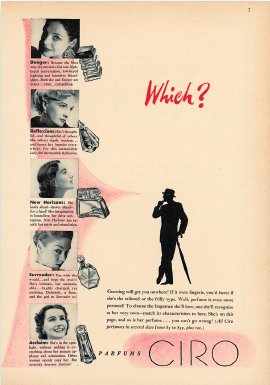
Prior to the 1970s, perfume ads often targeted men as purchasers of perfume for women. In this 1940s-era ad for Ciro’s line of perfumes, the silhouette of a puzzled man simply asks, “Which?” To the left is Ciro’s entire range of perfumes, meant for different types of women. Danger is for the woman who likes “very dry martinis and fast cars,” and New Horizons, for the woman who “looks ahead—moves ahead—and
has
a head!”
by Dana (1932)
Perfumer:
Jean Carles
In the same way that people want to drink a full-bodied red wine or drink a peaty scotch on winter days rather than, say, a vodka grapefruit, perfume lovers often veer toward fragrances in the Oriental category when it’s cold outside. A classic perfume in this category, Tabu provides the winter warmth you’re looking for and offers heat in other ways: It was created to project overt sexuality.
Created by perfumer Jean Carles of Ma Griffe, Shocking, and Miss Dior fame (which he created with Paul Vacher), it’s said that Dana’s brief to Carles was along the lines of, “Make a perfume a prostitute would wear.” Perhaps this was a signature; fans of
Carles’s other fragrance, Ma Griffe, have said that their grandmothers called that perfume “the prostitute’s perfume,” and both Shocking and Miss Dior have a whiff of ladies’ undergarments about them.
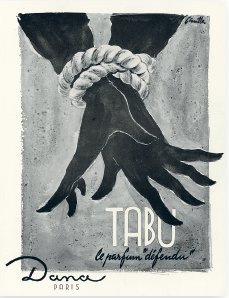
This 1950s-era French ad for Tabu, “The Forbidden Perfume,” had a decidedly S&M bent. (Artist: Camilla)
Sweet, ambery, spicy, and complex, Tabu’s sweetness comes from heady florals, clove, benzoin, and amber rather than the expected vanilla, which doesn’t appear, surprisingly, as a note. (Benzoin resin from the styrax tree’s bark has a pronounced vanilla facet embedded in heavy-cream richness, which accounts for the vanillic impression in Tabu.)
Go for demure perfumes if you must, but for me, if loving perfume that was made for prostitutes is wrong—I don’t wanna be right.
Top notes:
Bergamot, orange, neroli, coraner, spice notes
Heart notes:
Clove bud, ylang-ylang, rose, jasmine, narcissus, clover
Base notes:
Patchouli, civet, cedar, vetiver, sandalwood, benzoin, amber, musk, oakmoss
by Creed (1933)
Angélique Encens (Angelica or angelic incense)
is
heavenly, an animalic as light as a cloud, but with darkness and bite. Angélique Encens’s angelica, vanilla, and ambergris echo Shalimar’s holy trinity of bergamot, vanilla, and animal base. More ethereal and less carnal than Shalimar, Angélique Encens’s head is in the clouds, befitting its name.
Angélique or angelica is a genus of about sixty kinds of herbs in the family Apiacea that have a peppery, herbal, earthy, woody, and musky odor.
Angélique
is also a pun on the word
angelic,
with its connotations of heavenly, sweet, and divine.
Angélique Encens’s initial peppery/herbal notes combine with nose-tickling incense, followed by the downy-softest vanilla, with a musky, civet-like animal note
hovering in the background. Its florals are very much in the background like the perfume’s silver lining, adding sensuality from behind the scenes. The animal note recedes in the drydown, and you’re left with a whisper of a vanilla skin-scent. (This is a review of Creed’s final stock of Angélique Encens before they—unwisely—discontinued it.)
Top notes:
Angelica
Heart notes:
Rose, jasmine
Base notes:
Vanilla, incense, ambergris
(Notes from Creed’s website before Angélique Encens was discontinued.)
by Ciro (1933)
Boozy, rich, spicy, and vanillic, Reflections is in the Tabu/Styx Oriental family of perfumes, with an intense amber, patchouli, and powdery base, maybe with orris and sandalwood.
Notes not available.
by Lanvin (1933)
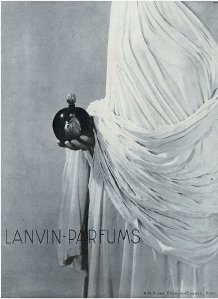
A toga-clad woman holds Lanvin’s distinctive, round black bottle like an offering from the gods. The bottle features the Lanvin logo—a stylized depiction of designer Jeanne Lanvin and her daughter in gold—designed by illustrator Paul Iribe.